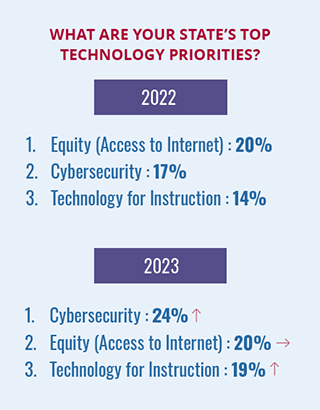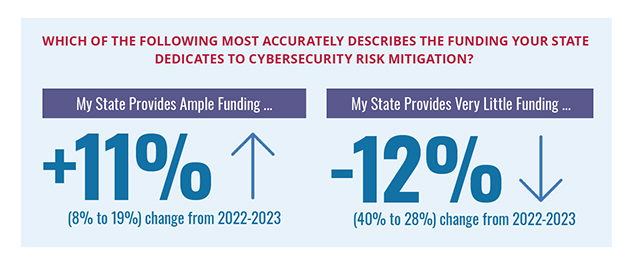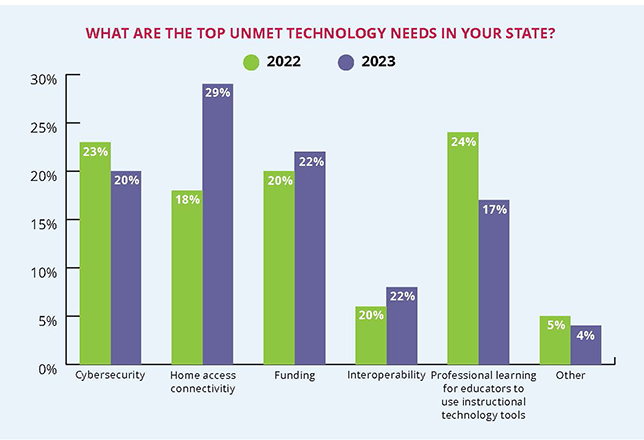Cybersecurity, AI Policy Top List of State Ed Tech Priorities
- By Kristal Kuykendall
- 09/18/23
New survey results from the State Education Technology Directors Association underscore the importance of collaboration across agencies and school districts as cybersecurity and AI pose the biggest unmet challenges for public education.
 Released by SETDA in collaboration with Whiteboard Advisors, the 2023 State Ed Tech Trends Report reveals results of the association’s annual survey of ed tech directors, state superintendents, chiefs of staff, and other senior education officials from 45 states, the District of Columbia, the Department of Defense Education Activity, and Guam, according to a news release.
Released by SETDA in collaboration with Whiteboard Advisors, the 2023 State Ed Tech Trends Report reveals results of the association’s annual survey of ed tech directors, state superintendents, chiefs of staff, and other senior education officials from 45 states, the District of Columbia, the Department of Defense Education Activity, and Guam, according to a news release.
The survey data is complemented by “spotlights” on several state education departments’ best practices in supporting cybersecurity efforts, the effective and equitable use of ed tech tools, and the development of policy to guide the use of AI in K–12 classrooms.
“State leaders can’t shy away from change or the technologies that bring it about. That’s not an option for the students we serve whose future success depends on their ability to thrive in an ever-changing, technology-rich world,” said Kirsten Baesler, superintendent of public instruction of the North Dakota Department of Public Instruction, in the preface to the 2023 report. “The SETDA State Ed Tech Trends report serves an invaluable purpose. It shows us that at state agencies, too, change is constant.”
Key Finding 1: Cybersecurity is the Top Need
Cybersecurity is now the top need, but still not receiving enough funding or support: The number of survey respondents who noted “cybersecurity” as their top technology priority increased between 2022 and 2023, yet 42% of respondents said their state provides a “small amount” or “very little” funding for cybersecurity needs.

“Improving K-12 cybersecurity posture has become an issue of resources and equity,” said Brad Hagg, director of education technology at the Indiana Department of Education. “Under-staffed districts and communities without access to a pipeline of cyber specialists will struggle to meet the requirements, often dictated by insurance companies, as well as the best practices necessary to implement a strong cybersecurity threat mitigation program.”
Key Finding 2: AI Guidance a Growing Need
State education officials report an “increased demand for guidance relating to artificial intelligence” and its use in K–12 schools, yet most states reported no efforts under way to meet that increased demand, SETDA said.
Key Finding 3: Home Connectivity Remains an Unmet Need
State education agencies responding to the survey said their biggest unmet need remains home access connectivity, with nearly one-third listing it as their top need.
“Comparing the data from the 2022 survey to this year’s results yields some compelling insights,” SETDA said. “Respondents in 2022 listed cybersecurity and professional learning on the use of ed tech as their top unmet needs. This year, states have responded by making those issues priorities in terms of money and time.
During the pandemic, home internet access was a major challenge for schools during closures, and districts spent billions to increase broadband connectivity, the report noted.
According to the Federal Communications Commission, reliable home internet access is still not available for about 17 million students.
“As with ensuring cybersecurity, providing reliable broadband to entire communities isn’t easy, often requiring cooperation across agencies (sometimes across states) and the private sector, not to mention significant funding. But in a world where access to the internet is critical — perhaps even a civil right — the stakes couldn’t be higher,” SETDA said in the report, which includes a spotlight on how New Mexico is addressing lack of home connectivity.

Key Finding 4: States Still Aim for More Effective Use of Ed Tech
“While states believe progress is being made on the effective use of ed tech tools, leaders still view this as an area of ongoing need,” the report said. “The number of states collecting data on the effectiveness of their edtech tools also increased according to respondents, and using edtech effectively to support instruction remains a top priority for state leaders.”
Download the full report at SETDA.org/priorities/state-trends/.